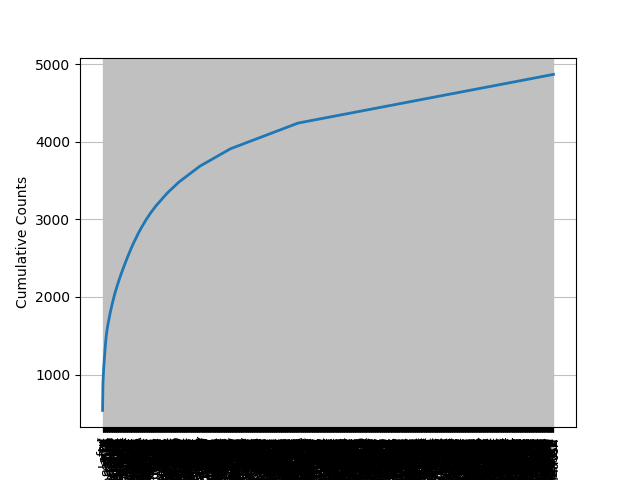原文链接:http://www.one2know.cn/nlp1/
- 访问语料库
NLTK数据库的安装:http://www.nltk.org/data.html
NLTK语料库列表:http://www.nltk.org/nltk_data/
内部访问(以Reuters corpus为例):
import nltk
from nltk.corpus import reuters
# 下载路透社语料库
nltk.download('reuters')
# 查看语料库的内容
files = reuters.fileids()
print(files)
# 访问其中一个文件的内容
words14826 = reuters.words(['test/14826'])
print(words14826[:20])
# 输出主题(一共90个)
reutersGenres = reuters.categories()
print(reutersGenres)
# 访问一个主题,一句话一行输出
for w in reuters.words(categories=['tea']):
print(w + ' ',end='')
if w is '.':
print()
- 下载外部语料库并访问(以影评数据集为例)
下载数据集:http://www.cs.cornell.edu/people/pabo/movie-review-data/
本例下载了1000积极和1000消极的影评
from nltk.corpus import CategorizedPlaintextCorpusReader
# 读取语料库
reader = CategorizedPlaintextCorpusReader(r'D:PyCharm 5.0.3WorkSpace2.NLP语料库1.movie_review_data_1000 xt_sentoken',r'.*.txt',cat_pattern=r'(w+)/*')
print(reader.categories())
print(reader.fileids())
# 语料库分成两类
posFiles = reader.fileids(categories='pos')
negFiles = reader.fileids(categories='neg')
# 从posFiles或negFiles随机选择一个文件
from random import randint
fileP = posFiles[randint(0,len(posFiles)-1)]
fileN = negFiles[randint(0,len(negFiles)-1)]
# 逐句打印随机的选择文件
for w in reader.words(fileP):
print(w + ' ',end='')
if w is '.':
print()
for w in reader.words(fileN):
print(w + ' ',end='')
if w is '.':
print()
CategorizedPlaintextCorpusReader类通过参数的设置,从内部将样本加载到合适的位置
- 语料库中的词频计算和计数分布分析
以布朗语料库为例:布朗大学 500个文本 15个类
import nltk
from nltk.corpus import brown
nltk.download('brown')
# 查看brown中的类别
print(brown.categories())
# 挑选出三种类别,并获取其中的疑问词
genres = ['fiction','humor','romance']
whwords = ['what','which','how','why','when','where','who']
# 迭代器分别分析3种类
for i in range(0,len(genres)):
genre = genres[i]
print()
print("Analysing '"+ genre + "' wh words")
genre_text = brown.words(categories = genre)
print(genre_text)
# 返回输入单词对象的wh类及对应的频率
fdist = nltk.FreqDist(genre_text)
for wh in whwords:
print(wh + ':',fdist[wh],end=' ')
print()
输出:
['adventure', 'belles_lettres', 'editorial', 'fiction', 'government', 'hobbies', 'humor', 'learned', 'lore', 'mystery', 'news', 'religion', 'reviews', 'romance', 'science_fiction']
Analysing 'fiction' wh words
['Thirty-three', 'Scotty', 'did', 'not', 'go', 'back', ...]
what: 128 which: 123 how: 54 why: 18 when: 133 where: 76 who: 103
Analysing 'humor' wh words
['It', 'was', 'among', 'these', 'that', 'Hinkle', ...]
what: 36 which: 62 how: 18 why: 9 when: 52 where: 15 who: 48
Analysing 'romance' wh words
['They', 'neither', 'liked', 'nor', 'disliked', 'the', ...]
what: 121 which: 104 how: 60 why: 34 when: 126 where: 54 who: 89
- 网络文本和聊天文本的词频分布
import nltk
from nltk.corpus import webtext
# nltk.download('webtext')
print(webtext.fileids())
# 选择一个数据文件,并计算频率分布,获得FreqDist的对象fdist
fileid = 'singles.txt' # 个人广告
wbt_words = webtext.words(fileid)
fdist = nltk.FreqDist(wbt_words)
# 获取高频单词及其计数
print('最多出现的词 "' , fdist.max() , '" :' , fdist[fdist.max()])
# 获取所有单词的计数
print(fdist.N())
# 找出最常见的10个词
print(fdist.most_common(10))
# 将单词和频率制成表格
print(fdist.tabulate(5))
# 将单词和频率制成分布图
fdist.plot(cumulative=True) # 计数显示,cumulative=percents为百分比显示
输出:
['firefox.txt', 'grail.txt', 'overheard.txt', 'pirates.txt', 'singles.txt', 'wine.txt']
最多出现的词 " , " : 539
4867
[(',', 539), ('.', 353), ('/', 110), ('for', 99), ('and', 74), ('to', 74), ('lady', 68), ('-', 66), ('seeks', 60), ('a', 52)]
, . / for and
539 353 110 99 74
None
累计计数分布图:

- 使用WordNet获取一个词的不同含义
# import nltk
# nltk.download('wordnet')
from nltk.corpus import wordnet as wn
chair = 'chair'
# 输出chair的各种含义
chair_synsets = wn.synsets(chair)
print('Chair的意思:',chair_synsets,'
')
# 迭代输出 含义,含义的定义,同义词条,例句
for synset in chair_synsets:
print(synset,': ')
print('Definition: ',synset.definition())
print('Lemmas/Synonymous words: ',synset.lemma_names())
print('Example: ',synset.examples(),'
')
输出:
Chair的意思: [Synset('chair.n.01'), Synset('professorship.n.01'), Synset('president.n.04'), Synset('electric_chair.n.01'), Synset('chair.n.05'), Synset('chair.v.01'), Synset('moderate.v.01')]
Synset('chair.n.01') :
Definition: a seat for one person, with a support for the back
Lemmas/Synonymous words: ['chair']
Example: ['he put his coat over the back of the chair and sat down']
Synset('professorship.n.01') :
Definition: the position of professor
Lemmas/Synonymous words: ['professorship', 'chair']
Example: ['he was awarded an endowed chair in economics']
Synset('president.n.04') :
Definition: the officer who presides at the meetings of an organization
Lemmas/Synonymous words: ['president', 'chairman', 'chairwoman', 'chair', 'chairperson']
Example: ['address your remarks to the chairperson']
Synset('electric_chair.n.01') :
Definition: an instrument of execution by electrocution; resembles an ordinary seat for one person
Lemmas/Synonymous words: ['electric_chair', 'chair', 'death_chair', 'hot_seat']
Example: ['the murderer was sentenced to die in the chair']
Synset('chair.n.05') :
Definition: a particular seat in an orchestra
Lemmas/Synonymous words: ['chair']
Example: ['he is second chair violin']
Synset('chair.v.01') :
Definition: act or preside as chair, as of an academic department in a university
Lemmas/Synonymous words: ['chair', 'chairman']
Example: ['She chaired the department for many years']
Synset('moderate.v.01') :
Definition: preside over
Lemmas/Synonymous words: ['moderate', 'chair', 'lead']
Example: ['John moderated the discussion']
- 上位词和下位词
下位词更具体,上位词更一般(泛化)
以bed.n.01和woman.n.01为例:
from nltk.corpus import wordnet as wn
woman = wn.synset('woman.n.01')
bed = wn.synset('bed.n.01')
# 返回据有直系关系的同义词集,上位词!
print(woman.hypernyms())
woman_paths = woman.hypernym_paths()
# 打印从根节点到woman.n.01的所有路径
for idx,path in enumerate(woman_paths):
print('
Hypernym Path :',idx+1)
for synset in path:
print(synset.name(),',',end='')
# 更具体的术语,下位词!
types_of_bed = bed.hyponyms()
print('
Types of beds(Hyponyms): ',types_of_bed)
# 打印出更有意义的lemma(词条)
print('
',sorted(set(lemma.name() for synset in types_of_bed for lemma in synset.lemmas())))
输出:
[Synset('adult.n.01'), Synset('female.n.02')]
Hypernym Path : 1
entity.n.01 ,physical_entity.n.01 ,causal_agent.n.01 ,person.n.01 ,adult.n.01 ,woman.n.01 ,
Hypernym Path : 2
entity.n.01 ,physical_entity.n.01 ,object.n.01 ,whole.n.02 ,living_thing.n.01 ,organism.n.01 ,person.n.01 ,adult.n.01 ,woman.n.01 ,
Hypernym Path : 3
entity.n.01 ,physical_entity.n.01 ,causal_agent.n.01 ,person.n.01 ,female.n.02 ,woman.n.01 ,
Hypernym Path : 4
entity.n.01 ,physical_entity.n.01 ,object.n.01 ,whole.n.02 ,living_thing.n.01 ,organism.n.01 ,person.n.01 ,female.n.02 ,woman.n.01 ,
Types of beds(Hyponyms): [Synset('berth.n.03'), Synset('built-in_bed.n.01'), Synset('bunk.n.03'), Synset('bunk_bed.n.01'), Synset('cot.n.03'), Synset('couch.n.03'), Synset('deathbed.n.02'), Synset('double_bed.n.01'), Synset('four-poster.n.01'), Synset('hammock.n.02'), Synset('marriage_bed.n.01'), Synset('murphy_bed.n.01'), Synset('plank-bed.n.01'), Synset('platform_bed.n.01'), Synset('sickbed.n.01'), Synset('single_bed.n.01'), Synset('sleigh_bed.n.01'), Synset('trundle_bed.n.01'), Synset('twin_bed.n.01'), Synset('water_bed.n.01')]
['Murphy_bed', 'berth', 'built-in_bed', 'built_in_bed', 'bunk', 'bunk_bed', 'camp_bed', 'cot', 'couch', 'deathbed', 'double_bed', 'four-poster', 'hammock', 'marriage_bed', 'plank-bed', 'platform_bed', 'sack', 'sickbed', 'single_bed', 'sleigh_bed', 'truckle', 'truckle_bed', 'trundle', 'trundle_bed', 'twin_bed', 'water_bed']
- 基于WordNet计算某种词性的多义性
以名词n为例:
from nltk.corpus import wordnet as wn
type = 'n' #动词v,副词r,形容词a
# 返回WordNet中所有type类型的同义词集
sysnets = wn.all_synsets(type)
# 将所有词条合并成一个大list
lemmas = []
for sysnet in sysnets:
for lemma in sysnet.lemmas():
lemmas.append(lemma.name())
# 删除重复词条,list=>set
lemmas = set(lemmas)
# 计算每个词条type类型的含义数并加到一起
count = 0
for lemma in lemmas:
count = count + len(wn.synsets(lemma,type)) # lemma在type类型下的所有含义
# 打印所有数值
print('%s总词条数: '%(type),len(lemmas))
print('%s总含义数: '%(type),count)
print('%s平均多义性: '%(type),count/len(lemmas))
输出:
n总词条数: 119034
n总含义数: 152763
n平均多义性: 1.2833560159282222